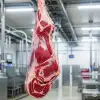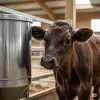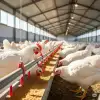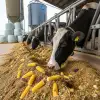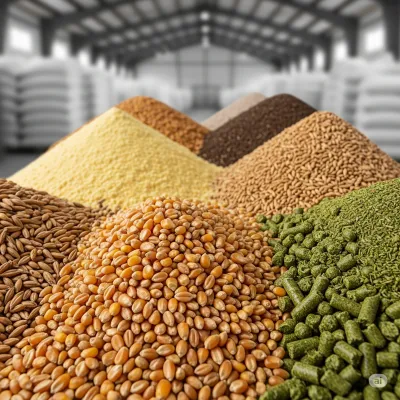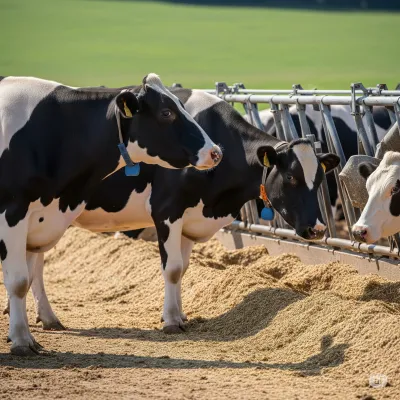Feed Additives: The Secret Heroes Boosting Animal Health and Performance
Feed additives are key to improving animal health, performance, and feed utilization in modern animal husbandry. This blog post details the main types of feed additives, their benefits, and proper usage methods.

Feed Additives: The Secret Heroes Boosting Animal Health and Performance
---In modern animal husbandry, feeding animals solely with basic nutrients (energy, protein, vitamins, minerals) is no longer sufficient. High yield targets, stress factors, disease pressure, and environmental conditions make special components added to rations—namely, **feed additives**—indispensable. Feed additives offer a wide range of benefits, from improving animal health and increasing feed utilization to enhancing productivity and reducing environmental impact. So, what are these "secret heroes" and how are they used?
Why Are Feed Additives Used?
The use of feed additives is one of the cornerstones of modern animal husbandry. Their main purposes are:
- Improving Animal Health: They strengthen the immune system, increasing resistance to diseases and preventing or reducing digestive disorders.
- Increasing Feed Utilization: They ensure better digestion of feeds and more efficient use of nutrients, thus enabling less feed consumption for the same yield.
- Enhancing Productivity: They boost performance parameters such as milk, meat, and egg production. They improve growth rate and feed conversion ratio.
- Preserving Feed Quality: They prevent the spoilage of feeds (mold, oxidation) during storage.
- Reducing Environmental Impact: By increasing feed utilization, they reduce nutrient excretion in feces, thereby lowering the environmental footprint.
Main Types and Benefits of Feed Additives
Feed additives are divided into different groups according to their functions:
1. Digestive Modifiers
- Probiotics (Live Yeasts and Bacteria): They support the balance of beneficial microorganisms in the rumen and intestines. They improve feed digestion, regulate lactic acid production, inhibit the proliferation of pathogenic bacteria, and strengthen immunity. They are particularly effective during stressful periods (calving, ration changes).
- Prebiotics: These are indigestible feed components (e.g., Mannan-oligosaccharides (MOS), Fructo-oligosaccharides (FOS)) that stimulate the growth and activity of probiotics (beneficial bacteria). They support gut health and immunity.
- Enzymes: They improve the digestion of feed components that cannot be sufficiently broken down by the animal's own digestive enzymes (e.g., phytate, non-starch polysaccharides). This increases nutrient digestibility and allows for better feed utilization. Enzymes such as phytase, cellulase, and amylase are commonly used.
2. Metabolic and Nutritional Enhancers
- Vitamins: Vital for animals' growth, reproduction, immunity, and general metabolic functions. Vitamins A, D, E, K, and B-group vitamins are added to rations. Especially Vitamin E and Selenium strengthen immunity with their antioxidant effects.
- Minerals (Trace and Macro): Necessary for bone development, enzyme activity, hormone synthesis, and immunity. In addition to macro minerals like calcium, phosphorus, and magnesium, highly bioavailable (organic or chelated) forms of trace minerals such as zinc, copper, selenium, and chromium are preferred.
- Amino Acids: Essential amino acids, especially rumen-protected methionine and lysine, optimize protein synthesis to increase milk and meat production and improve feed utilization.
3. Rumen Buffers and Acid Regulators
- Sodium Bicarbonate (Baking Soda): Stabilizes rumen pH, preventing acidosis. Used particularly in rations containing high concentrate feed or in early lactation.
- Magnesium Oxide: Helps balance rumen pH and is a source of magnesium.
4. Toxin Binders
- Mycotoxin Binders: Bind harmful mycotoxins (aflatoxin, zearalenone, etc.) found in moldy feeds, preventing their absorption into the animal's body. This prevents health problems and production losses caused by toxins. Clay minerals (bentonite) and yeast cell wall products (glucomannans) are commonly used.
5. Antioxidants
- Vitamin E, Selenium, Vitamin C: Reduce oxidative stress caused by free radicals in the body. They protect cells, strengthen the immune system, and improve meat and milk quality.
6. Feed Quality Preservatives
- Anti-mold Agents (Propionic Acid, Formic Acid): Prevent the formation of mold and yeast during feed storage, helping to preserve nutritional value.
- Antioxidants (Preventers of Feed Oxidation): Especially in fatty feeds, they prevent oxidation (spoilage), extending the shelf life of feeds and preserving their palatability.
7. Flavor and Odor Enhancers
- Flavorings: Make feeds more palatable, encouraging feed intake by animals. Can be beneficial especially during stressful periods, new ration transitions, or in cases of appetite loss.
8. Special Additives
- Plant Extracts (Essential Oils): Some plant extracts may have antibacterial, anti-inflammatory, or appetite-stimulating properties.
- Omega Fatty Acids: Can support reproductive performance, the immune system, and general health.
Proper Selection and Use of Feed Additives
The effectiveness of feed additives depends on using the right product at the correct dose and at the right time. When selecting, the following should be considered:
- Needs Analysis: Needs should be determined by considering animal species, age, production purpose (milk, meat, reproduction), health status, ration content, and environmental conditions.
- Expert Consultation: Seeking support from a veterinarian or animal nutrition specialist will help you choose the most suitable additives and determine dosages.
- Quality and Reliability: Prefer licensed and quality products from reliable brands, supported by scientific research.
- Dosage and Application: Always strictly adhere to the manufacturer's recommended dosages and application instructions. Excessive or insufficient use can lead to undesirable results.
Conclusion: Maximizing Performance with a Scientific Approach
Feed additives are powerful tools for optimizing animal health and performance in modern animal husbandry. However, it should not be forgotten that additives cannot compensate for basic nutrition or poor management. When used in conjunction with a balanced ration, good barn management, and regular health checks, feed additives can significantly increase the profitability and sustainability of your operation. With a scientific and needs-based approach, you can maximize your animals' potential.
Which feed additives do you use and how do you observe their benefits? Share your experiences with us in the comments!
